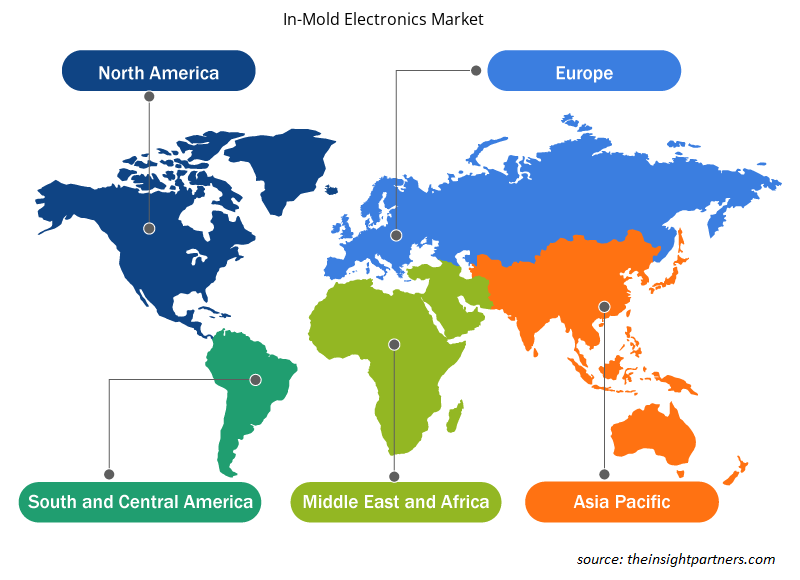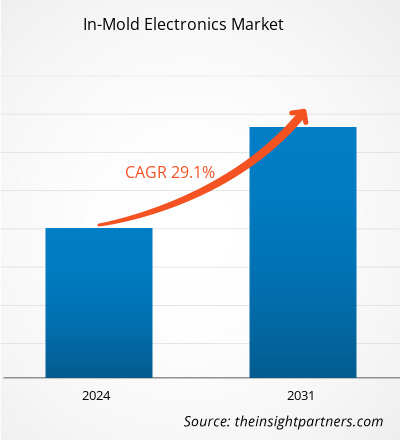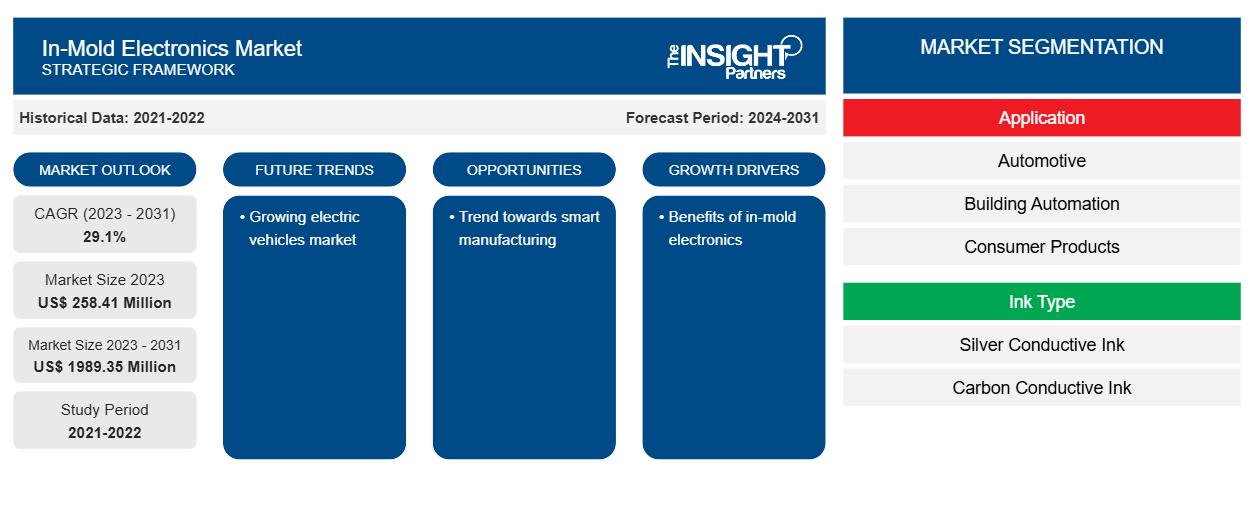Der Markt für In-Mold-Elektronik soll von 258,41 Millionen US-Dollar im Jahr 2023 auf 1.989,35 Millionen US-Dollar im Jahr 2031 anwachsen. Der Markt soll zwischen 2023 und 2031 eine durchschnittliche jährliche Wachstumsrate (CAGR) von 29,1 % verzeichnen. Der wachsende Markt für Unterhaltungselektronik und die steigende Nachfrage aus dem Automobilsektor dürften weiterhin der Schlüssel zu den Markttrends für In-Mold-Elektronik sein.
Marktanalyse für In-Mold-Elektronik
Mehrere Schlüsselfaktoren tragen zur wachsenden Beliebtheit von In-Mold-Elektronik bei. In-Mold-Elektronik ermöglicht die Erstellung schlanker, unauffälliger Schnittstellen, die sich problemlos in das Gesamtdesign des Produkts einfügen. Diese Integration verbessert das Benutzererlebnis und erhöht die Nachfrage bei den Verbrauchern. Ein weiterer Faktor ist, dass der Wegfall zusätzlicher Komponenten wie Leiterplatten und Anschlüsse die Montage vereinfacht und die Gesamtherstellungskosten senkt. Der rationalisierte Produktionsprozess ermöglicht eine schnellere Markteinführung, was In-Mold-Elektronik zu einer attraktiven Option für Unternehmen macht, die enge Fristen einhalten und sich einen Wettbewerbsvorteil verschaffen möchten.
Marktübersicht für In-Mold-Elektronik
In-Mold-Elektronik ist ein Herstellungsverfahren, bei dem elektronische Schaltkreise mit einer geformten Kunststoffkomponente kombiniert werden. Durch die Kombination traditioneller Spritzgusstechniken mit gedruckter Elektronik macht In-Mold-Elektronik separate Leiterplatten, Anschlüsse und Kabel überflüssig. Leitfähige Spuren, Berührungssensoren und andere elektronische Komponenten werden direkt in die Oberfläche des Kunststoffs integriert, was zahlreiche Vorteile gegenüber herkömmlichen Methoden bietet. Es wird häufig für Haushaltsgeräte, Armaturenbretter, medizinische Geräte, Luft- und Raumfahrt und tragbare Elektronik verwendet.
Passen Sie diesen Bericht Ihren Anforderungen an
Sie erhalten kostenlos individuelle Anpassungen an jedem Bericht, einschließlich Teilen dieses Berichts oder einer Analyse auf Länderebene, eines Excel-Datenpakets sowie tolle Angebote und Rabatte für Start-ups und Universitäten.
-
Holen Sie sich die wichtigsten Markttrends aus diesem Bericht.Dieses KOSTENLOSE Beispiel umfasst eine Datenanalyse von Markttrends bis hin zu Schätzungen und Prognosen.
Treiber und Chancen auf dem In-Mold-Electronics-Markt
Vorteile von In-Mold-Elektronik für den Markt
In-Mold-Elektronik kann dekorative Grafiken, Beleuchtung und vieles mehr enthalten, was zu ihrer Nachfrage bei den Verbrauchern führt. Sie bietet mehr Gestaltungsflexibilität, verbesserte Zuverlässigkeit und Haltbarkeit, eine deutliche Platz- und Gewichtsreduzierung, verbesserte Touch-Leistung, einfache Montage und Nachhaltigkeit. In-Mold-Elektronik hat in mehreren Branchen an Beliebtheit gewonnen, beispielsweise für Mensch-Maschine-Schnittstellen wie Passagiersteuergeräte, Fernbedienungen, Schnittstellen für Kabinenmanagementsysteme, Patientenüberwachungssysteme, Haushaltsgeräte, Heimsicherheitssysteme und mehr. Darüber hinaus ist sie auch eine beliebte Wahl für Autoinnenräume und Flugzeugkabinen aufgrund ihrer schlanken und kompakten Designs.
Wachsender Markt für Elektrofahrzeuge
Aufgrund der zunehmenden Besorgnis über Klimawandel und Luftverschmutzung wird die Nachfrage nach Elektrofahrzeugen in Zukunft voraussichtlich steigen. Die Regierungen mehrerer Länder sind dabei, verschiedene Initiativen und Richtlinien einzuführen, um die Herstellung von Elektrofahrzeugen voranzutreiben und so zu einer grüneren Zukunft beizutragen. Daher wird die Produktion von Elektrofahrzeugen eine Nachfrage nach In-Mold-Elektronik erzeugen, um den elektronischen Anteil zu erhöhen, die Komplexität zu verringern und das Gewicht der Fahrzeuge zu reduzieren. Einige der unten genannten Fälle werden voraussichtlich die Produktion von Elektrofahrzeugen in naher Zukunft ankurbeln.
- Im September 2022 kündigte die US-Regierung ihren Plan an, die Produktion von Elektrofahrzeugen anzukurbeln. Bis 2030 soll das Land voraussichtlich 50 % des gesamten Elektrofahrzeugabsatzes erreichen. Unternehmen wie Honda, Toyota, General Motors, Ford Motor Company und Panasonic haben Investitionen in die Fertigungssektoren in North Carolina, Missouri, Michigan, Kansas und Ohio angekündigt, um dieses Ziel zu erreichen.
- Im Mai 2022 hatte Stellantis geplant, 2,8 Milliarden US-Dollar auszugeben, um die Produktion von Elektrofahrzeugen in zwei seiner kanadischen Werke zu steigern. Zur Unterstützung dieser Investition planten die Regierungen von Kanada und Ontario, bis zu 410,7 Millionen US-Dollar bzw. 398 Millionen US-Dollar zu investieren, um die inländische Produktion von Elektrofahrzeugen zu steigern und die Lieferkettenengpässe zu mildern.
- Die Regierung der Vereinigten Arabischen Emirate plant, 42.000 Elektroautos auf den Markt zu bringen, die bis 2030 auf den Straßen sein werden. Unterstützende politische Maßnahmen und Anreize bieten wichtigen Akteuren gute Möglichkeiten, die Einführung von Elektrofahrzeugen im Land zu fördern.
Segmentierungsanalyse des Marktberichts für In-Mold-Elektronik
Wichtige Segmente, die zur Ableitung der Marktanalyse für In-Mold-Elektronik beigetragen haben, sind Tintentyp und Anwendung.
- Nach Anwendung ist der Markt segmentiert in Automobil, Gebäudeautomation, Konsumgüter, Wearables, Gesundheitswesen und andere. Das Automobilsegment wird voraussichtlich mit der höchsten durchschnittlichen jährlichen Wachstumsrate wachsen.
- Basierend auf dem Tintentyp ist der Markt in leitfähige Silbertinte, leitfähige Kohlenstofftinte und andere unterteilt. Das Segment der leitfähigen Silbertinte hatte im Jahr 2023 einen größeren Marktanteil.
In-Mold-Elektronik – Marktanteilsanalyse nach geografischer Lage
Der geografische Umfang des Marktberichts für In-Mold-Elektronik ist hauptsächlich in fünf Regionen unterteilt: Nordamerika, Asien-Pazifik, Europa, Naher Osten und Afrika sowie Südamerika/Süd- und Mittelamerika.
In Bezug auf den Umsatz hatte der asiatisch-pazifische Raum im Jahr 2023 den größten Marktanteil im Bereich In-Mold-Elektronik. Die Präsenz einer großen Anzahl von Elektronikherstellern in der Region führt zum Marktwachstum der Region. Der Anstieg des Bevölkerungswachstums treibt die Nachfrage nach Unterhaltungselektronik in der Region an und treibt den Einsatz von In-Mold-Elektroniktechnologie voran. Der Anstieg des verfügbaren Einkommens der Menschen in Schwellenländern wie Indien und China führt zu ihrer starken Kaufkraft für Elektronik, was wiederum zu einer wachsenden Nachfrage nach In-Mold-Elektroniktechnologie führt.
Regionale Einblicke in den Markt für In-Mold-Elektronik
Die regionalen Trends und Faktoren, die den Markt für In-Mold-Elektronik im Prognosezeitraum beeinflussen, wurden von den Analysten von Insight Partners ausführlich erläutert. In diesem Abschnitt werden auch die Marktsegmente und die Geografie für In-Mold-Elektronik in Nordamerika, Europa, im asiatisch-pazifischen Raum, im Nahen Osten und Afrika sowie in Süd- und Mittelamerika erörtert.

- Erhalten Sie regionale Daten zum Markt für In-Mold-Elektronik
Umfang des Marktberichts für In-Mold-Elektronik
| Berichtsattribut | Details |
|---|---|
| Marktgröße im Jahr 2023 | 258,41 Millionen US-Dollar |
| Marktgröße bis 2031 | 1989,35 Millionen US-Dollar |
| Globale CAGR (2023 - 2031) | 29,1 % |
| Historische Daten | 2021-2022 |
| Prognosezeitraum | 2024–2031 |
| Abgedeckte Segmente |
Nach Anwendung
|
| Abgedeckte Regionen und Länder |
Nordamerika
|
| Marktführer und wichtige Unternehmensprofile |
|
Marktdichte von In-Mold-Elektronik: Auswirkungen auf die Geschäftsdynamik verstehen
Der Markt für In-Mold-Elektronik wächst rasant, angetrieben durch die steigende Nachfrage der Endnutzer aufgrund von Faktoren wie sich entwickelnden Verbraucherpräferenzen, technologischen Fortschritten und einem größeren Bewusstsein für die Vorteile des Produkts. Mit steigender Nachfrage erweitern Unternehmen ihr Angebot, entwickeln Innovationen, um die Bedürfnisse der Verbraucher zu erfüllen, und nutzen neue Trends, was das Marktwachstum weiter ankurbelt.
Die Marktteilnehmerdichte bezieht sich auf die Verteilung der Firmen oder Unternehmen, die in einem bestimmten Markt oder einer bestimmten Branche tätig sind. Sie gibt an, wie viele Wettbewerber (Marktteilnehmer) in einem bestimmten Marktraum im Verhältnis zu seiner Größe oder seinem gesamten Marktwert präsent sind.
Die wichtigsten Unternehmen auf dem Markt für In-Mold-Elektronik sind:
- Celanese Corporation
- e 2 ip
- DuraTech Industries
- Ost-West-Fertigung
- sabine_sabine
- Golden Valley Produkte
Haftungsausschluss : Die oben aufgeführten Unternehmen sind nicht in einer bestimmten Reihenfolge aufgeführt.

- Überblick über die wichtigsten Akteure auf dem In-Mold-Elektronikmarkt
Neuigkeiten und aktuelle Entwicklungen zum Markt für In-Mold-Elektronik
Der Markt für In-Mold-Elektronik wird durch die Erfassung qualitativer und quantitativer Daten nach Primär- und Sekundärforschung bewertet, die wichtige Unternehmensveröffentlichungen, Verbandsdaten und Datenbanken umfasst. Im Folgenden finden Sie eine Liste der Entwicklungen auf dem Markt:
- Im September 2022 gab X2F bekannt, dass es eine einzigartige Zusammenarbeit mit Covestro, einem der weltweit führenden Hersteller hochwertiger Polymermaterialien, eingegangen ist, um einen wärmeleitenden Automobilkühlkörper mit In-Mold-Elektronik unter Verwendung der transformativen kontrollierten Viskositätsformtechnologie von X2F zu entwickeln. Dieses neue Produkt war eine einzigartige Alternative für Automobilhersteller und -verarbeiter, die einen Ersatz für Aluminiumgusskühlkörper suchen, der sowohl leichter als auch kostengünstiger ist. (Quelle: X2F, Pressemitteilung, 2022)
Marktbericht zu In-Mold-Elektronik – Abdeckung und Ergebnisse
Der Bericht „Marktgröße und Prognose für In-Mold-Elektronik (2021–2031)“ bietet eine detaillierte Analyse des Marktes, die die folgenden Bereiche abdeckt:
- Marktgröße und Prognose auf globaler, regionaler und Länderebene für alle wichtigen Marktsegmente, die im Rahmen des Projekts abgedeckt sind
- Marktdynamik wie Treiber, Beschränkungen und wichtige Chancen
- Wichtige Zukunftstrends
- Detaillierte PEST/Porters Five Forces- und SWOT-Analyse
- Globale und regionale Marktanalyse mit wichtigen Markttrends, wichtigen Akteuren, Vorschriften und aktuellen Marktentwicklungen
- Branchenlandschaft und Wettbewerbsanalyse, einschließlich Marktkonzentration, Heatmap-Analyse, prominenten Akteuren und aktuellen Entwicklungen
- Detaillierte Firmenprofile
- Historische Analyse (2 Jahre), Basisjahr, Prognose (7 Jahre) mit CAGR
- PEST- und SWOT-Analyse
- Marktgröße Wert/Volumen – Global, Regional, Land
- Branchen- und Wettbewerbslandschaft
- Excel-Datensatz
Aktuelle Berichte
Erfahrungsberichte
Grund zum Kauf
- Fundierte Entscheidungsfindung
- Marktdynamik verstehen
- Wettbewerbsanalyse
- Kundeneinblicke
- Marktprognosen
- Risikominimierung
- Strategische Planung
- Investitionsbegründung
- Identifizierung neuer Märkte
- Verbesserung von Marketingstrategien
- Steigerung der Betriebseffizienz
- Anpassung an regulatorische Trends























 Kostenlose Probe anfordern für - Markt für In-Mold-Elektronik
Kostenlose Probe anfordern für - Markt für In-Mold-Elektronik